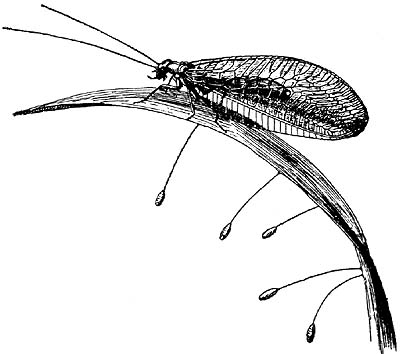
BUG OF THE MONTH: October 1994
Green Lacewings:
Order Neuroptera, family Chrysopidae
Copyright © 1994 by Louise Kulzer
This article originally appeared in Scarabogram, Oct. 1994, New Series No. 174, pp. 2-3.
|
|
| Chrysopa, adult and eggs |
Green lacewings are beloved by gardeners, for the larval stage is fiercely predatory. The adults reportedly feed on pollen, nectar, and aphid honeydew (Bland, 1978). Not as common as lady-bird beetles, they have a delicate beauty with their netted lace-like wings, soft green hue, and golden eyes. The eggs are laid elevated on stiff silk stalks which bounce around when bumped. I remember a lacewing that had laid eggs in a baby food jar where I had temporarily detained it. When the jar was shaken, the eggs vibrated in a wonderfully surrealistic way!
Neuropterans, the order to which green lacewings belong, are fairly primitive among those insects with complete metamorphosis. The wings have numerous veins and cross-veins, and in flight they flap asynchronously, both primitive characteristics. The adults have chewing mouthparts and the larvae have long, hollow, sickle-shaped jaws (Smith et al. 1943). The appearance of the larvae is made more distinctive by tubercles with hair tufts along the sides of the abdomen (see figure). Sometimes the larvae carry debris such as lichens, apparently for camouflage.
|
|
| Chrysopa larva |
A fascinating thing I recently learned about green lacewings is that they produce primitive mating songs by tremulation. Tremulation involves vibrating the abdomen without touching the substrate, producing low frequency sounds. Green lacewings always sing (tremulate) before mating. A recent study of these courtship songs found that in one species, Chrysoperla plorabunda, the songs acted as effective isolating mechanisms, differentiating separate morphs within what had appeared to be one sympatric species (Wells and Henry 1992). Such non-obvious species are referred to as "cryptic."
Now that's some bug -- predatory as larvae, possessing delicate beauty as adults, and a cryptic singer! Make sure the next lacewing you encounter gets the respect it deserves.
References
Bland, R.G. 1978. How to know the insects. Pictured Key Nature Series, Wm. C. Brown Co., Dubuque, Iowa.
Canard, Michael. 1998. Life history strategies of green lacewings in temperate climates: a review (Neuroptera, Chrysopidae). in Neuropterology 1997 (Proceedings of the 6th International Sumposium on Neuropterology), Acta Zoologica Fennica 209: 65-74.
Perry, N.D., P.A. Adams, and L.A. Strange. 1997. Species catalog of the Neuroptera, Megaloptera, and Raphidioptera of America North of Mexico. Proceedings of the California Academy of Sciences, 50: 39-114.
Smith, R.C., E.G. Kelly, G.A. Dean, H.R. Bryson, & R.L. Parker. 1943. Common insects of Kansas. Kansas State Board of Agriculture, Topeka.
Wells, M.M., & C.S. Henry. 1992. The role of courtship songs in reproductive isolation among populations of green lacewings of the genus Chrysoperla (Neuroptera: Chrysopidae). Ecology 46(1): 31-42.
This page last updated 16 June, 2005